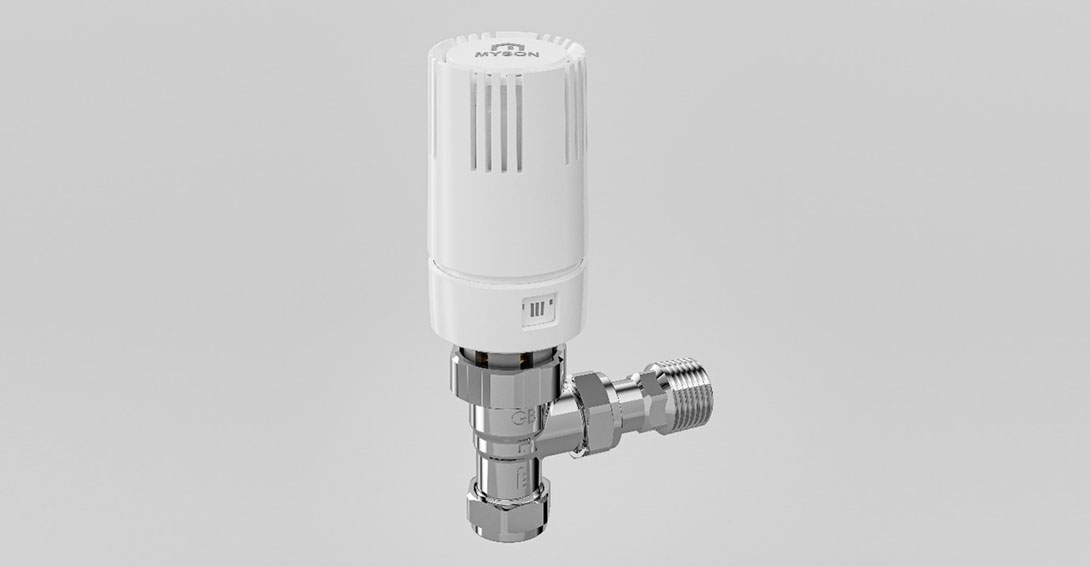News
The added value of thermostatic radiator valves in energy saving
Creating the right indoor climate is often about finding the right balance between comfort and energy consumption. To that end all components of a heating and cooling system need to be aligned. That includes the heat source, the distribution and the emitters, but also the right control solution. Let’s look at how thermostatic radiator valves can help to maintain a comfortable temperature while optimising energy consumption.

The role of a thermostatic radiator valve
A thermostatic radiator valve regulates the flow of hot water through a radiator. A sensor inside the TRV reacts to the surrounding temperature and expands or contracts, depending on the set value on the TRV dial, to either restrict or increase the amount of hot water flowing to the radiator. This technology helps to guarantee a high level of control accuracy so that it’s easy to combine optimal energy consumption with maximum comfort.
The TRV turns the radiator off once the room temperature corresponds to the setting. When the sensor detects that the room temperature has dropped, the thermostatic radiator valve will open automatically to increase the flow of hot water again so that the radiator can reheat the room. This results in more efficient heating without compromising on comfort.
Saving energy with thermostatic radiator valves
According to BEAMA, the average energy saving potential from fitting TRVs throughout the home is 18% of the heating costs.
When a radiator system is designed, the radiators are dimensioned based on their ability to heat a room when the outdoor temperature is at its coldest. However, during the months when a heating system is being used, typically there are only a few days with an outside temperature that requires every radiator in the building to be fully on. On other days, the radiators would be producing excess heat, resulting in overheated rooms and wasted energy.
When thermostatic valves are installed on every radiator throughout a building, it’s easy to control the preferred temperature in each individual room. You can, for example, keep the living room comfortably warm when you’re watching TV, but easily lower the temperature in the kitchen when you’re cooking. A thermostatic radiator valve is thus an easy means to get more control over the room temperature and helps to ensure rooms aren’t heated more than they need to be. This way spaces aren’t overheated and no energy is lost on unoccupied rooms so that ultimately TRVs help to save energy as well as increase indoor climate comfort.
Energy saving with TRVs on a pan-European scale
Based on a report by the European Building Automation and Controls Association, about 70 million homes around Europe have only manual radiator valves installed on their radiators, which amounts to approximately 500 million radiators that can potentially be upgraded with thermostatic radiator valves. TRVs on all the radiators that don’t have them could save 130 TWh of energy every year. Upgrading TRVs that are over 20 years old would increase this to 160 TWh. With a potential reduction of 29 million tonnes of EU CO2 emissions, that’s a big win for the planet.
Although TRVs undoubtedly help to heat a building efficiently, it’s important to note that there are multiple factors involved in just how much energy can be saved. The degree of insulation, the heat source, the heat output of the radiators as well as the number of rooms where a TRV is used, all affects the energy consumption, and thus the potential energy savings.
Low temperature heating & thermostatic radiator valves
In view of energy efficiency, many people are also switching to low temperature heating. This means the water circulating in the radiators is somewhere between 30 and 50°C, instead of 70 to 80°C. In addition to a lower surface temperature for the radiators, the lower water temperature also means that the fluid flow increases. In an existing pipe system, the friction can therefore increase significantly, which in turn increases the need for hydronic balancing.
The balancing can easily be done with adjustable thermostatic radiator valves. TRVs limit the mass flow to the radiator whenever necessary so that an unbalanced water distribution is avoided, helping to create the ideal operating conditions for a hydronic heating system.
For more information on the full range of valves, go to https://www.myson.co.uk/products/heating-valves.htm


